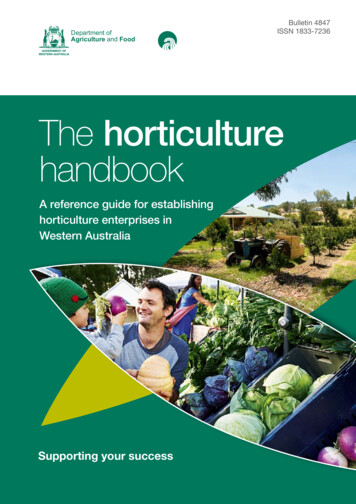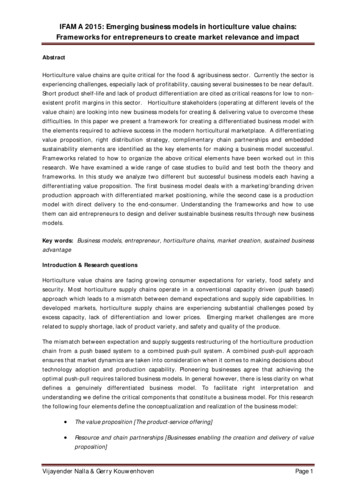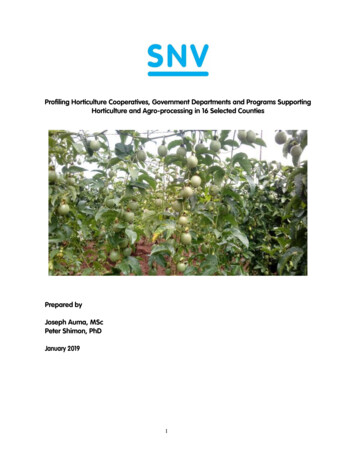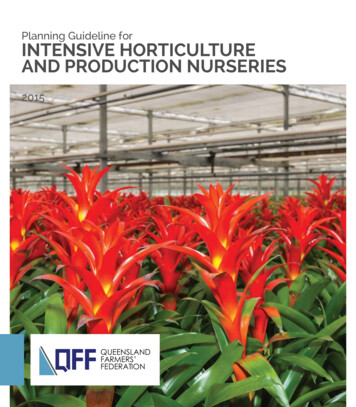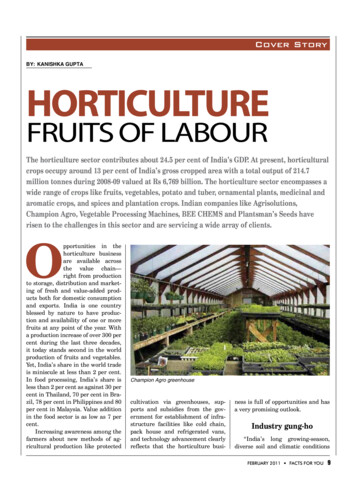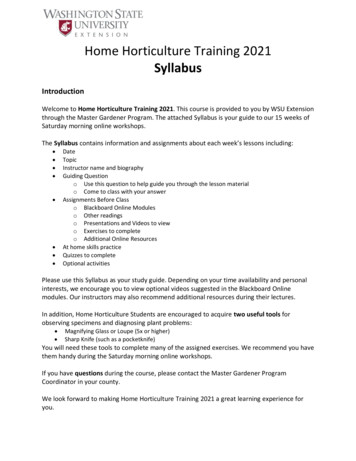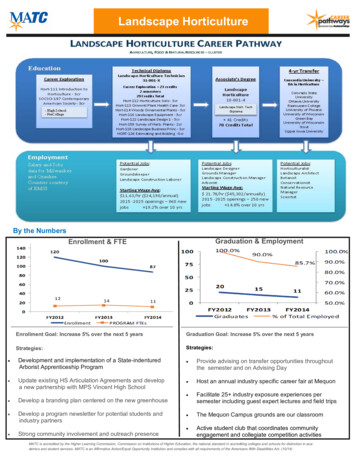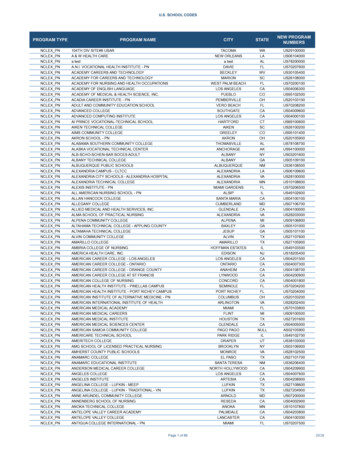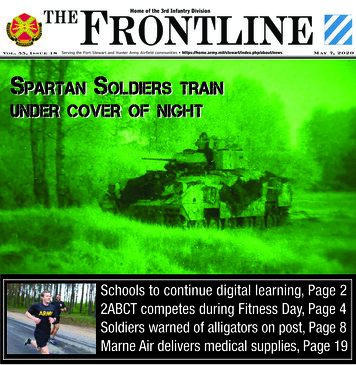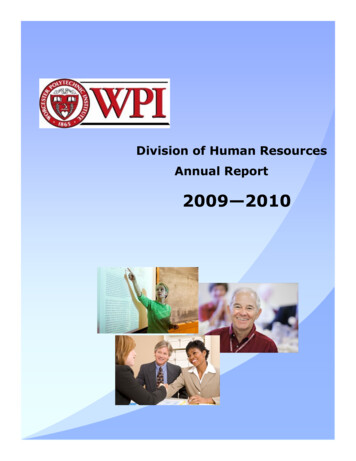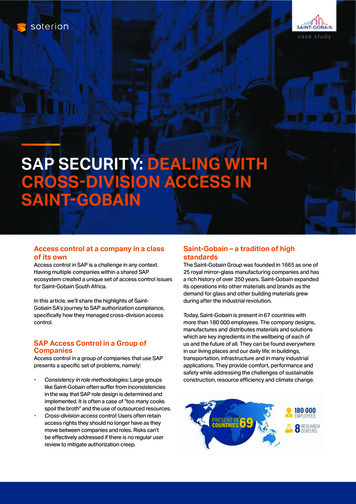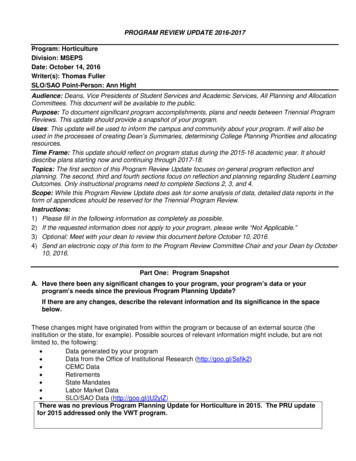
Transcription
PROGRAM REVIEW UPDATE 2016-2017Program: HorticultureDivision: MSEPSDate: October 14, 2016Writer(s): Thomas FullerSLO/SAO Point-Person: Ann HightAudience: Deans, Vice Presidents of Student Services and Academic Services, All Planning and AllocationCommittees. This document will be available to the public.Purpose: To document significant program accomplishments, plans and needs between Triennial ProgramReviews. This update should provide a snapshot of your program.Uses: This update will be used to inform the campus and community about your program. It will also beused in the processes of creating Dean’s Summaries, determining College Planning Priorities and allocatingresources.Time Frame: This update should reflect on program status during the 2015-16 academic year. It shoulddescribe plans starting now and continuing through 2017-18.Topics: The first section of this Program Review Update focuses on general program reflection andplanning. The second, third and fourth sections focus on reflection and planning regarding Student LearningOutcomes. Only instructional programs need to complete Sections 2, 3, and 4.Scope: While this Program Review Update does ask for some analysis of data, detailed data reports in theform of appendices should be reserved for the Triennial Program Review.Instructions:1) Please fill in the following information as completely as possible.2) If the requested information does not apply to your program, please write “Not Applicable.”3) Optional: Meet with your dean to review this document before October 10, 2016.4) Send an electronic copy of this form to the Program Review Committee Chair and your Dean by October10, 2016.Part One: Program SnapshotA. Have there been any significant changes to your program, your program’s data or yourprogram’s needs since the previous Program Planning Update?If there are any changes, describe the relevant information and its significance in the spacebelow.These changes might have originated from within the program or because of an external source (theinstitution or the state, for example). Possible sources of relevant information might include, but are notlimited to, the following: Data generated by your program Data from the Office of Institutional Research (http://goo.gl/Ssfik2) CEMC Data Retirements State Mandates Labor Market Data SLO/SAO Data (http://goo.gl/jU2ylZ)There was no previous Program Planning Update for Horticulture in 2015. The PRU updatefor 2015 addressed only the VWT program.
B. What objectives, initiatives, or plans from the 2015 Program Review Update have been achievedand how? PRUs from 2015 are available here: http://goo.gl/9iF3m9There was no previous Program Planning Update for Horticulture in 2015. The PRU updatefor 2015 addressed only the VWT program.C. Discuss at least one example of how students have been impacted by the work of your programsince the last program review update (if you did not already answer this in Question B).The last PRU that included Horticulture was 2014. Since 2014 Horticulture has offered twodaytime classes, Introduction to Horticulture. This has helped us reach out to younger fulltime students, who were not being reached by an evening only schedule. The down-side, isthat part-time evening students, who work during the daytime, have not been able tocomplete the Intro class which is required for the AS Degree or the Certificate.D. What obstacles has your program faced in achieving objectives, initiatives, or plans?As stated in C., continuing evening students have been unable to complete the requiredclass, Introduction to Horticulture. The cancellation of this Fall’s class, Hort. 55, also aDegree and Certificate requirement, has further hampered our students from completingtheir AS Degrees, or Certificates. The limited course offerings (2 per semester, and none insummer) make it impossible to complete either the AS Degree, or the Certificate within 2years. It is not possible to finish the program in less than 4 years. Most students need morethan 4 years to finish. In order to complete the program, students often need to resort tosubstituting horticulture classes that they would not have chosen, for the courses theyactually need or desire. This has a very negative impact on enrollment, driving manyseriously interested horticulture students to Merritt, DVC, or Delta Colleges.E. What are your most important plans (either new or continuing) for next year?1. We are planning to continue the expansion of our course offering from 2 to 3 classes asemester, while attempting to boost our enrollment. However, this has been difficult for us,as our past history of limited class offerings hurts our recruitment efforts.2. We are focusing part of our spring curriculum on the construction of a small aquaponicssystem in our greenhouse in an effort to attract students interested in more sustainablehorticultural concepts.3. We will try a more aggressive approach to advertising our program.4. We will actively involve ourselves in the planning and development of a new andimproved horticultural facility to be constructed with Measure A funding.5. Hiring a full-time instructor.6. Updating curriculum (course outlines) for the following courses: H54, H55, H58, H59, &H60. Additional courses (pending the availability of funding) also in need of upgradinginclude: H62, H67, H95, & H96.7. Submitting curriculum for a new course Fundamentals of Hydroponics/Aquaponics.F. Instructional Programs: Detail your department’s plans, if any, for adding DE courses, degrees,and/or certificates. For new DE degrees and/or certificates (those offered completely online),please include a brief rationale as to why the degree/certificate will be offered online.
We don’t have any plans at this time to add DE courses. Although DE might be possible fora couple of our courses, most horticulture courses have a lab element, which is much betterserved by hands-on participation.G. Do plans listed under Question E or Question F connect to this year’s planning priorities (listedbelow)? If so, explain how they connect.Planning Priorities for 2016-17 Establish regular and ongoing processes to implement best practices to meet ACCJCstandards Provide necessary institutional support for curriculum development and maintenance Develop processes to facilitate ongoing meaningful assessment of SLOs and integrateassessment of SLOs into college processes Expand tutoring services to meet demand and support student success in BasicSkills, CTE and Transfer courses.Our plans connect most directly to the CTE program. Conventional tutoring available oncampus hasn’t been particularly useful. However, most of the actual tutoring that occurs,happens due to the interaction of older, more experienced students, with younger studentsthat are new to Horticulture. The recent hiring of a Hort/VWT lab technician is also provingto be valuable resource for students to master basic horticultural skills.H. Instructional programs: Did your program meet its program-set standard for successful coursecompletion? x yes no(This data can be found here: http://goo.gl/Ssfik2)If your program did not meet your program-set standard, discuss possible reasons and how thismay affect program planning or resource requests.N/AI. Units with SAOs: Using SAO data from last year, describe the impacts of SAO practices on studentlearning, achievement, or institutional effectiveness. Describe the practices which led to thesuccess. (Copy the box below if you would like to discuss multiple examples). SAO data can befound here: http://goo.gl/jU2ylZSAO: No SAO dataDescribe the quantitative or qualitative results: N/ADiscuss any actions taken so far (and results, if known): N/ADiscuss your action plan for the future: N/A
Part Two: Course-Level SLO Assessment ScheduleTHIS SECTION HAS BEEN REMOVED. PLEASE SKIP TO PART THREE.
Part Three: Assessment Results(Instructional Programs Only)1. Describe an example of how your program used course SLO data (SLOs) from last year (2015-16)to impact student learning or achievement. (Copy the box below if you would like to discuss multipleexamples).Course: Horticulture 50Course SLO: The student will be able to propagate a plant by taking a cutting.Describe the quantitative or qualitative results: Students all participated successfully in makingvegetative cuttings, and propagating them.Discuss any actions taken so far (and results, if known): Successfully propagated cuttings weresold at subsequent plant sales events, with the proceeds being used to buy supplies for theprogram.Discuss your action plan for the future: We plan to continue this activity, and find additional planthost materials to propagate a wider variety of plants.2. Degree/Certificate granting programs only: Describe an example of how your program usedprogram-level SLO data (PSLOs) from last year (2015-16) to impact student learning orachievement. (Copy the box below if you would like to discuss multiple examples).Degree/Certificate: HorticultureProgram SLO: The successful student will be able to select plant materials for a given landscapebased on water requirements, soil type, pest and disease resistance,growth habits, and design requirementsDescribe the quantitative or qualitative results: Success rates were satisfactoryDiscuss any actions taken so far (and results, if known): Some lesson plans have been revisedand updated.Discuss your action plan for the future:Lesson plans are annually updated to improve instruction and keep courses relevant toon-going developments in the field of horticulture
Part Four: Program Curriculum Map(Instructional Programs with Degrees/Certificates Only)Background: Program-level Student Learning OutcomesProgram-level Student Learning Outcomes (PSLOs) are defined as the knowledge, skills,abilities, or attitudes that students have at the completion of a degree or certificate. Facultywithin a discipline should meet to discuss the expected learning outcomes for students whocomplete a particular series of courses, such as those required for a certificate or a degree.PSLOs should be the big things you want students to get out of a degree or certificate. PSLOsshould be developed throughout the program and in multiple courses. Discussions might alsoinvolve colleagues in other programs regarding prerequisites and transfer courses or communitystakeholders regarding job expectations.It is recommended that each program have 3-6 PSLOs. Discipline faculty members might needto have a more comprehensive list based on the requirements of external stakeholders(employers, state requirements, etc.). For most programs, PSLOs are only assessed throughlinked course-level SLOs. You might assess PSLOs in a capstone project or capstone coursethat many students complete when earning a certificate or degree. Alternatively, you couldassess development of a set of skills as students advance through different courses in yourprogram (ENG 1A - ENG 4 or 7).Program-level outcomes should1.describe what students are able to do after completing a degree or certificate;2.be limited in number (3-6 outcomes);3.be clear so that students and colleagues can understand them;4.be observable skills (career-specific or transferable), knowledge, attitudes, and/or values;5.be relevant to meet the needs of students, employers, and transfer institutions;6.be rigorous yet realistic outcomes achievable by students
Curriculum Map DirectionsNote: If you have multiple degrees/certificates, choose one to map. If you have already submittedmapping to the SLO committee and do not wish to make changes, you may copy that mapping intothis chart or attach the map you already created.1. In the boxes across the top row, review all the non-GE courses required for your degree/certificate.(including those that aren’t in your discipline). Make any desired changes to those courses.(Electives do not need to be included, though they may).2. In the left column, write the program learning outcomes you have drafted for your program.3. In the boxes in the center of the page, mark the course SLO that maps to the program SLO you haveidentified. Each program SLO should map to multiple courses in your program.Example: English Associate’s Degree for TransferRequired Courses in Degree/CertificateProgram Learning OutcomesEng 4Eng 71. Identify and evaluate impliedarguments in college-level literarytexts.x2. Write an academic essaysynthesizing multiple texts andusing logic to support a thesis.xx3. Write a research paper usingcredible sources and correctdocumentation.xx4. Analyze an author’s use ofliterary techniques to develop atheme.*Including electives is optional.Eng 35Eng 41Electives*(Eng 20, 32,45, 44)MSCM 1*xxxx
Your Program’s MapDegree or Certificate: Certificate option - Landscape Installation and MaintenanceProgramLearningOutcomes (3-6recommended)1. Thesuccessfulstudent will beable toaccuratelyidentify a setof plantmaterial.2. Thesuccessfulstudent will beable to use thatplant material ina landscapedesign3. Thesuccessfulstudent will beable to preparea maintenanceschedule for thechosen plantmaterials4.5.6.Required Courses in Degree/CertificateHort Hort Hort Hort Hort Hort Hort Hort Hort Hort xx1. Did you make any changes to your existing mapping? (circle one)YesNoThis degree/certificate did not have previous mapping2. If you answered “yes” to Question 1, explain what changes you made.3. Reflection Questions: The following questions are for the consideration of your program as you look atyour completed chart. You do not need to record your responses here. If you discuss these questions withothers (for example, at a department meeting), you may want to take minutes documenting your discussion.a. How many courses help students achieve each program outcome? Do students have enoughopportunities to achieve the outcome? All courses help achieve the program outcomes. No,infrequent scheduling of courses hampers students from achieving the program outcomes.
b. In which course(s) are students likely to demonstrate satisfactory achievement of each programoutcome? In other words, which courses(s) might be an official or unofficial capstone requirement?Hort. 50, Hort. 51, Hort. 52, Hort. 56, Hort. 57, Hort. 58, and Hort. 59.
Degree and Certificate requirement, has further hampered our students from completing their AS Degrees, or Certificates. The limited course offerings (2 per semester, and none in summer) make it impossible to complete either the AS Degree, or the Certificate within 2 years. It is
